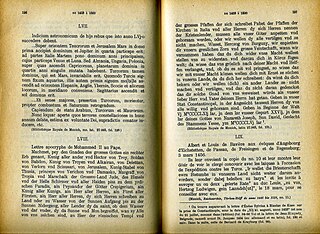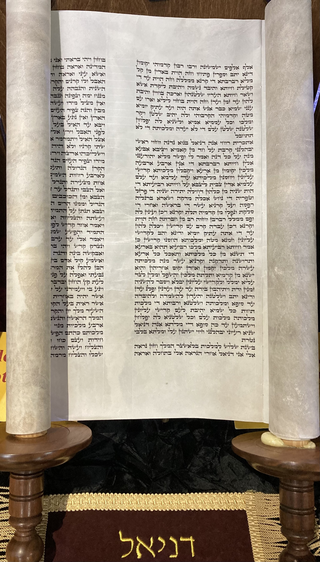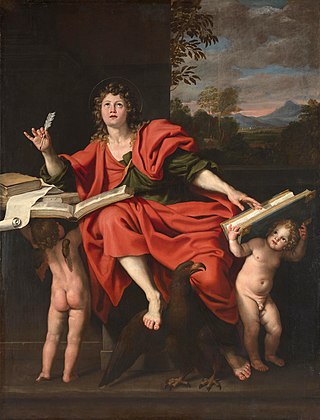Date and authorship
In form, the Second Apocalypse appears to have been influenced by the Questions and Answers of Ephraim the Syrian (died 373). An early date for its composition puts it in the late fourth or early fifth century. François Nau dated it no later than the early eighth century on the grounds that it appeared unaffected either by the rise of Islam in the seventh century or by Byzantine iconoclasm in the next. He thought it was written in Cyprus. Alice Whealey, however, argues that there are signs the author was writing with Muslims and iconoclasts in mind, which would place its composition during the iconoclast period (726–843). She argues that it was written in a place that experienced Islamic rule or at least attack (such as Cyprus). Tony Burke places its composition in 4th-century Roman Syria.
The earliest reference to the Second Apocalypse is found in a mid-ninth century scholion on Dionysius Thrax. It must have been written before this date. The scholiast, while clarifying that the Apocalypse of Paul was named for Paul of Samosata, notes that the apocalyptic text "called the Apocalypse of the Theologian" (i.e., the Second Apocalypse) was not in fact "of the one in the island of Patmos, God forbid, for that one [the Book of Revelation ] is supremely true; but of a pseudonymous and spurious one".
The Second Apocalypse is pseudonymous, being falsely attributed to John of Patmos. For convenience, its anonymous author is sometimes called Pseudo-John of Patmos. On the basis of style, Nau identified the author of the Second Apocalypse as the same person who wrote what he called the Second Apocryphal Greek Apocalypse of Saint John, which is not an apocalypse but a collection of canons. It too is falsely attributed to John of Patmos. It consists of a series of answers given by Jesus to questions posed by John on matters of Christian ethics and rites.
Content
The Second Apocalypse is a series of questions by John about the end times with answers by Jesus. It may have been written as a supplement to John of Patmos' Book of Revelation. It contains details about the physical appearance of the Beast and life on the New Earth. Its language and choice of imagery is distinctly rural. A date of composition after the early Muslim conquests of the seventh century has been invoked to explain the text's concern with the preservation of icons, crosses and bibles—all of which Jesus says he will bring up to Heaven before destroying the Earth. A reference to Christian emperors being driven like slaves and wailing like infants may reflect the author's disgust with their support of iconoclasm.
There will be "no risk of racial discrimination in Heaven", according to John Court, but no bodily resurrection either, according to the following passage:
Just as the bees do not differ one from another, but are all of the same appearance and size, so every human being will be at the resurrection. Not fair-skinned, nor red-skin, nor black, not Ethiopian nor different facial features, but all will rise with the same appearance and size. The whole human species will rise bodiless.
John Court, accepting an early date for the Second Apocalypse, identifies it as part of a "Johannine apocalyptic tradition", which also includes the Apocalypse of John Chrysostom , the Third Apocalypse of John and the Coptic Apocalypse of John . On the basis of her later dating, Whealey questions the validity of this classification. Nevertheless, the work is often classified as among the New Testament apocrypha.

Apocrypha are biblical or related writings not forming part of the accepted canon of scripture, some of which might be of doubtful authorship or authenticity. In Christianity, the word apocryphal (ἀπόκρυφος) was first applied to writings that were to be read privately rather than in the public context of church services. Apocrypha were edifying Christian works that were not always initially included as canonical scripture.

The Book of Daniel is a 2nd century BC biblical apocalypse with a 6th century BC setting. Ostensibly "an account of the activities and visions of Daniel, a noble Jew exiled at Babylon", the text features a prophecy rooted in Jewish history, as well as a portrayal of the end times that is both cosmic in scope and political in its focus. The message of the text intended for the original audience, was that just as the God of Israel saves Daniel from his enemies, so he would save the Israelites in their present oppression.

The Book of Revelation or Book of the Apocalypse is the final book of the New Testament. Written in Koine Greek, its title is derived from the first word of the text: apokalypsis, meaning 'unveiling' or 'revelation'. The Book of Revelation is the only apocalyptic book in the New Testament canon. It occupies a central place in Christian eschatology.

John the Apostle, also known as Saint John the Beloved and, in Eastern Orthodox Christianity, Saint John the Theologian, was one of the Twelve Apostles of Jesus according to the New Testament. Generally listed as the youngest apostle, he was the son of Zebedee and Salome. His brother James was another of the Twelve Apostles. The Church Fathers identify him as John the Evangelist, John of Patmos, John the Elder, and the Beloved Disciple, and testify that he outlived the remaining apostles and was the only one to die of natural causes, although modern scholars are divided on the veracity of these claims.
The oldest surviving Hebrew Bible manuscripts, the Dead Sea Scrolls, date to c. the 2nd century BCE. Some of these scrolls are presently stored at the Shrine of the Book in Jerusalem. The oldest text of the entire Christian Bible, including the New Testament, is the Codex Sinaiticus dating from the 4th century CE, with its Old Testament a copy of a Greek translation known as the Septuagint. The oldest extant manuscripts of the vocalized Masoretic Text date to the 9th century CE. With the exception of a few biblical sections in the Nevi'im, virtually no biblical text is contemporaneous with the events it describes.

A pseudepigraph is a falsely attributed work, a text whose claimed author is not the true author, or a work whose real author attributed it to a figure of the past. The name of the author to whom the work is falsely attributed is often prefixed with the particle "pseudo-", such as for example "pseudo-Aristotle" or "pseudo-Dionysius": these terms refer to the anonymous authors of works falsely attributed to Aristotle and Dionysius the Areopagite, respectively.

The Apocalypse of Peter, also called the Revelation of Peter, is an early Christian text of the 2nd century and a work of apocalyptic literature. It is the earliest-written extant work depicting a Christian account of heaven and hell in detail. The Apocalypse of Peter is influenced by both Jewish apocalyptic literature and Greek philosophy of the Hellenistic period. The text is extant in two diverging versions based on a lost Koine Greek original: a shorter Greek version and a longer Ethiopic version.

The New Testament apocrypha are a number of writings by early Christians that give accounts of Jesus and his teachings, the nature of God, or the teachings of his apostles and of their lives. Some of these writings were cited as scripture by early Christians, but since the fifth century a widespread consensus has emerged limiting the New Testament to the 27 books of the modern canon. Roman Catholic, Eastern Orthodox, and Protestant churches generally do not view the New Testament apocrypha as part of the Bible.

The authorship of the Johannine works has been debated by biblical scholars since at least the 2nd century AD. The debate focuses mainly on the identity of the author(s), as well as the date and location of authorship of these writings.
The name "Esdras" is found in the title of four texts attributed to, or associated with, the prophet Ezra. The naming convention of the four books of Esdras differs between church traditions, and has changed over time.

The Apocalypse of Thomas is a work from the New Testament apocrypha, apparently composed originally in Greek. It concerns the end of the world, and appears to be influenced by the Apocalypse of John, although it is written in a less mystical and cosmic manner. The Apocalypse of Thomas is the inspiration for the popular medieval millennial list Fifteen Signs before Doomsday.

Daniel 2 tells how Daniel related and interpreted a dream of Nebuchadnezzar II, king of Babylon. In his night dream, the king saw a gigantic statue made of four metals, from its head of gold to its feet of mingled iron and clay; as he watched, a stone "not cut by human hands" destroyed the statue and became a mountain filling the whole world. Daniel explained to the king that the statue represented four successive kingdoms beginning with Babylon, while the stone and mountain signified a kingdom established by God which would never be destroyed nor given to another people. Nebuchadnezzar then acknowledges the supremacy of Daniel's God and raises him to high office in Babylon.
Written between the 2nd and 5th centuries AD, in Greek, the Apocalypse of Sedrach, also known as the Word of Sedrach, is an ancient apocryphal text. It is preserved only in one 15th century manuscript. The text was published by M. R. James and translated into English by A. Rutherford. Apparently the original apocalypse was composed between AD 150 and 500, it was joined with a lengthy sermon on love to reach its final form shortly after AD 1000. The original was probably Jewish, but this was later edited to take on a Christian flavour.
Daniel 7 tells of Daniel's vision of four world-kingdoms replaced by the kingdom of the saints or "holy ones" of the Most High, which will endure for ever. Four beasts come out of the sea, the Ancient of Days sits in judgment over them, and "one like a son of man" is given eternal kingship. An angelic guide interprets the beasts as kingdoms and kings, the last of whom will make war on the "holy ones" of God, but they will be destroyed and the "holy ones" will be given eternal dominion and power.

The Cave of the Apocalypse is located approximately halfway up the mountain on the Aegean island of Patmos, along the road between the villages of Chóra and Skala. This grotto marks the spot where St. John of Patmos received his visions that he recorded in the Book of Revelation. It became a location of Christian pilgrimage and is recognized as a Greek Orthodox Church to this day. In 1999, UNESCO declared the cave a joint World Heritage Site, as one of the most sacred sites of Christianity.

The name John is prominent in the New Testament and occurs numerous times. Among Jews of this period, the name was one of the most popular, borne by about five percent of men. Thus, it has long been debated which Johns are to be identified with which.

Infancy gospels are a genre of religious texts that arose in the 2nd century. They are part of New Testament apocrypha, and provide accounts of the birth and early life of Jesus. The texts are of various and uncertain origin, and are generally non-canonical in major modern branches of Christianity. They include the Gospel of James, which introduces the concept of the Perpetual Virginity of Mary, and the Infancy Gospel of Thomas, both of which cover many miraculous incidents from the life of Mary and the childhood of Jesus that are not included in the canonical gospels. Although the Life of John the Baptist focuses on John the Baptist rather than Jesus or his immediate family, it is also included in the genre as its events would be contemporary with Jesus's early life.

The Acts of John in Rome is a 4th-century Christian apocryphal text that presents stories about the Apostle John. The text, written in Greek, is believed to be based on orally handed down stories about the works of John in Rome.

The Apocalypse of John Chrysostom, also called the Second Apocryphal Apocalypse of John, is a Christian text composed in Greek between the 6th and 8th centuries AD. Although the text is often called an apocalypse by analogy with the similarly structured First Apocryphal Apocalypse of John, the text is not a true apocalypse. In the manuscripts, it is called "a word of teaching" or "a treatise". It is usually classified as part of the New Testament apocrypha because it describes an apocryphal encounter between John of Patmos and Jesus. In a number of manuscripts, it is presented as a sermon of John Chrysostom, who, rather than the apostle, is Jesus's interlocutor.
The Investiture of Abbaton, the Enthronement of Abbaton, or the Encomium on Abbaton, is an apocalyptic, pseudepigraphical, and apocryphal text. It describes the creation of Adam by God, Jesus, and the Holy Spirit; the fall of Satan; and the transformation of Muriel into Abbaton, the angel of death. The sole extant copy is dated to 981, and while its present version probably dates to the 700s, it may have an original from the 600s. It is purportedly written by Timothy of Alexandria.










